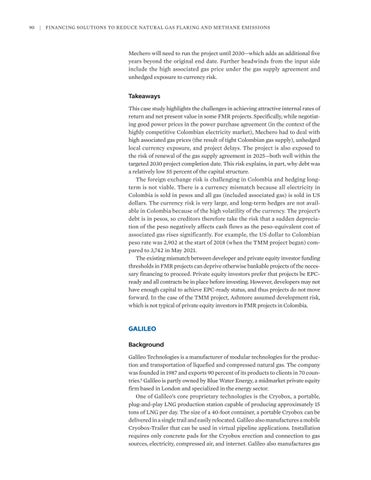90
| Financing Solutions to Reduce Natural Gas Flaring and Methane Emissions
Mechero will need to run the project until 2030—which adds an additional five years beyond the original end date. Further headwinds from the input side include the high associated gas price under the gas supply agreement and unhedged exposure to currency risk.
Takeaways This case study highlights the challenges in achieving attractive internal rates of return and net present value in some FMR projects. Specifically, while negotiating good power prices in the power purchase agreement (in the context of the highly competitive Colombian electricity market), Mechero had to deal with high associated gas prices (the result of tight Colombian gas supply), unhedged local currency exposure, and project delays. The project is also exposed to the risk of renewal of the gas supply agreement in 2025—both well within the targeted 2030 project completion date. This risk explains, in part, why debt was a relatively low 55 percent of the capital structure. The foreign exchange risk is challenging in Colombia and hedging longterm is not viable. There is a currency mismatch because all electricity in Colombia is sold in pesos and all gas (included associated gas) is sold in US dollars. The currency risk is very large, and long-term hedges are not available in Colombia because of the high volatility of the currency. The project’s debt is in pesos, so creditors therefore take the risk that a sudden depreciation of the peso negatively affects cash flows as the peso-equivalent cost of associated gas rises significantly. For example, the US dollar to Colombian peso rate was 2,902 at the start of 2018 (when the TMM project began) compared to 3,742 in May 2021. The existing mismatch between developer and private equity investor funding thresholds in FMR projects can deprive otherwise bankable projects of the necessary financing to proceed. Private equity investors prefer that projects be EPCready and all contracts be in place before investing. However, developers may not have enough capital to achieve EPC-ready status, and thus projects do not move forward. In the case of the TMM project, Ashmore assumed development risk, which is not typical of private equity investors in FMR projects in Colombia.
GALILEO Background Galileo Technologies is a manufacturer of modular technologies for the production and transportation of liquefied and compressed natural gas. The company was founded in 1987 and exports 90 percent of its products to clients in 70 countries.9 Galileo is partly owned by Blue Water Energy, a midmarket private equity firm based in London and specialized in the energy sector. One of Galileo’s core proprietary technologies is the Cryobox, a portable, plug-and-play LNG production station capable of producing approximately 15 tons of LNG per day. The size of a 40-foot container, a portable Cryobox can be delivered in a single trail and easily relocated. Galileo also manufactures a mobile Cryobox-Trailer that can be used in virtual pipeline applications. Installation requires only concrete pads for the Cryobox erection and connection to gas sources, electricity, compressed air, and internet. Galileo also manufactures gas


